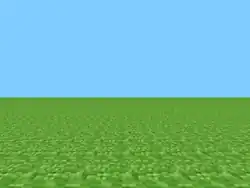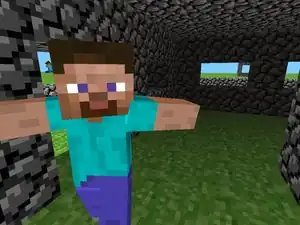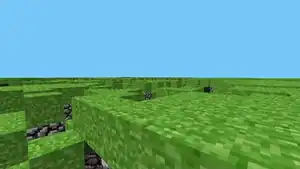Java Edition pre-Classic

| Starting version |
Cave game tech test |
|---|---|
| Latest version |
rd-161348 (May 16, 2009) (unreleased) |
| Paid |
No |
| Website |
N/A |
{
"title": "Pre-Classic",
"images": [
"Pre-Classic rd-132211.png"
],
"rows": [
{
"field": "''(link to Cave game tech test article, displayed as Cave game tech test)''<br>(May 13, 2009) (unreleased)",
"label": "Starting version"
},
{
"field": "(link to Java Edition pre-Classic rd-161348 article, displayed as rd-161348) (May 16, 2009) (unreleased)",
"label": "Latest version"
},
{
"field": "No",
"label": "Paid"
},
{
"field": "N/A",
"label": "Website"
}
],
"invimages": [],
"footer": "<div style=\"display:inline-block\">\n\n<div style=\"display:inline-block;padding:0 .4em\">[[Java Edition Classic|Java Edition Classic <span style=\"margin-right:-0.35em\">►</span>►]]</div>\n</div>"
}
Pre-Classic is the name given to the prototype versions of Minecraft (what is now Java Edition) developed before Classic. It was the very first development phase of the game, lasting for less than a week; very early development of the game started around May 10[1] or 11[2] before ending a week later on May 16, 2009. No pre-Classic versions were publicly released at the time. The original title was "Cave Game" until it was changed to "Minecraft: Order of the Stone", then to simply "Minecraft".
History

This phase began when Markus Persson (Notch) started working on a "Cave Game". He was influenced to create the game by Infiniminer, Dwarf Fortress and Dungeon Keeper, as well as one of his previous games, RubyDung.

The textures used for grass and stone blocks (the latter eventually being reworked for cobblestone) were from said game, and internally, the game's class files referred to it as "RubyDung". Other blocks and items were soon added, such as saplings, dirt, stone, and planks. Mobs, which would later become the player model, were also added, their model and texture reused from another of Notch's earlier games, Zombie Town.
Little is known about this development phase, since it was never publicly released, and only Notch could test the versions. Some versions in this phase could previously be seen in videos on Notch's YouTube channel Nizzotch, though most of the videos have been blocked in most countries for unknown reasons.
A tech test was shown in Notch's "Cave game tech test" video (archive) on May 10, 2009. The ability to place blocks was not present at the time.
This stage of development ended less than a week later on May 16, 2009. Four pre-Classic versions were later made available to the public through the launcher, with the earliest being rd-132211, originally developed on May 13, 2009. All of them are modified in 2013, making them technically not original.
Features
- Physics
- Grass block
- Mobs
- Level generator
- Particles
- Cobblestone
- Mob spawning: pressing (G)
- The void
- The ability to respawn somewhere else on the world by pressing (R)
- Placing blocks by left-clicking
- Destroying blocks by right-clicking
- World saving by pressing (
↵ Enter) or when closing the game by pressing (Esc)
Versions
- Cave game tech test
- Java Edition pre-Classic rd-132211
- Java Edition pre-Classic rd-132328
- Java Edition pre-Classic rd-20090515
- Java Edition pre-Classic rd-160052
- Java Edition pre-Classic rd-161348
Trivia
- Breaking a block doesn't drop anything, as the ability to drop an item was not yet added.
- When loading a pre-Classic version using the launcher, instead of the window title being "Minecraft" it is simply titled "Game".
- The name "Order of the Stone" was later reused in the spin-off game Minecraft: Story Mode as a legendary team of adventurers.
- The naming system in this phase Mojang retroactively used is "rd-ddhhmm", where "rd" stands for RubyDung, an earlier project of Notch's, and the ddhhmm part is a timestamp referring to the build time in the Europe/Stockholm timezone: dd is day of the month, hh is the hour, and mm is the minute released, so for example, rd-132211 was built on May 13 at 22:11. An exception to this system is rd-20090515, which instead uses the full date in the year-month-day format.
- All pre-Classic versions that were made are considered lost as the only archives of each version were modified on August 6th 2013.
See also
References
- ↑ "About the game" (Archive) – Minecraft, June 2009.
- ↑ Rotab's IRC logs on Archive.org; #minecraft.20090525.log. May 25, 2009 (UTC+2). "(10:40:09) <@Notch> heh, the game game tech test video is from the 13'th"[...]"(10:40:18) <@Notch> that was after two days of work, so I started the 11'th, probably"
| Java Edition |
| ||
|---|---|---|---|
| Bedrock Edition |
| ||
| Minecraft Education |
| ||
| MinecraftEDU | |||
| Legacy Console Edition | |||
| New Nintendo 3DS Edition | |||